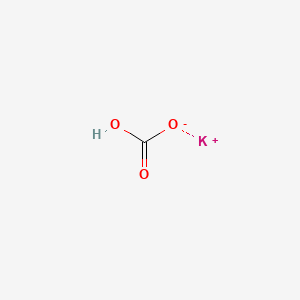
Synopsis
Synopsis
0
CEP/COS
0
JDMF
0
EU WC
0
KDMF
0
VMF
0
EDQM
0
USP
0
JP
0
Others
0
FDA Orange Book

0
South Africa

DRUG PRODUCT COMPOSITIONS
0
US Patents
0
US Exclusivities
0
Health Canada Patents
Annual Reports
NA
0
FDF
0
Data Compilation #PharmaFlow
0
Stock Recap #PipelineProspector
0
Weekly News Recap #Phispers
0
News #PharmaBuzz


1. Khco3
2. Potassium Hydrocarbonate
1. 298-14-6
2. Potassium Hydrogen Carbonate
3. Potassium Hydrogencarbonate
4. Potassium Acid Carbonate
5. Monopotassium Carbonate
6. Carbonic Acid, Monopotassium Salt
7. Potassiumbicarbonate
8. Khco3
9. Potassium;hydrogen Carbonate
10. Armicarb
11. Kafylox
12. Kaligreen
13. Milstop
14. Purple K
15. Hm5z15lebn
16. Potassium Carbonate Solution
17. Potassium Bicarbonate [usp]
18. Chebi:81862
19. Ins-501(ii)
20. E-501(ii)
21. Mfcd00011402
22. Potassium Bicarbonate (usp)
23. Ccris 3510
24. Einecs 206-059-0
25. Unii-hm5z15lebn
26. Epa Pesticide Chemical Code 073508
27. Potasium Bicarbonate
28. Potassium Bicabonate
29. Potassium Bicarbonat
30. Pbc
31. Einecs 241-378-9
32. K-vescent (tn)
33. Potassiumhydrogencarbonate
34. Potassium Hydogencarbonate
35. Potassium;hydron;carbonate
36. Ec 206-059-0
37. Potassium Hydrogen-carbonate
38. Schembl2420
39. Ins No.501(ii)
40. Chembl2106975
41. Dtxsid0021177
42. Potassium Bicarbonate, Acs Grade
43. Potassium Bicarbonate [ii]
44. Potassium Bicarbonate [mi]
45. Potassium Bicarbonate [fcc]
46. Potassium Bicarbonate [inci]
47. Potassium Bicarbonate [vandf]
48. Potassium Bicarbonate [mart.]
49. Akos009159056
50. Carbonic Acid, Potassium Salt (1:1)
51. Potassium Bicarbonate [usp-rs]
52. Potassium Bicarbonate [who-dd]
53. Db11098
54. E501
55. Potassium Carbonate Solution [fcc]
56. Ft-0645098
57. Potassium Bicarbonate [usp Monograph]
58. C18606
59. D02077
60. Potassium Bicarbonate, Trace Metals Grade 99.98%
61. Potassium Hydrogen Carbonate [ep Monograph]
62. Q410529
63. J-017655
| Molecular Weight | 100.115 g/mol |
|---|---|
| Molecular Formula | CHKO3 |
| Hydrogen Bond Donor Count | 1 |
| Hydrogen Bond Acceptor Count | 3 |
| Rotatable Bond Count | 0 |
| Exact Mass | 99.95627537 g/mol |
| Monoisotopic Mass | 99.95627537 g/mol |
| Topological Polar Surface Area | 60.4 Ų |
| Heavy Atom Count | 5 |
| Formal Charge | 0 |
| Complexity | 33.9 |
| Isotope Atom Count | 0 |
| Defined Atom Stereocenter Count | 0 |
| Undefined Atom Stereocenter Count | 0 |
| Defined Bond Stereocenter Count | 0 |
| Undefined Bond Stereocenter Count | 0 |
| Covalently Bonded Unit Count | 2 |
Potassium bicarbonate is used as an antacid, electrolyte replenisher and potassium supplement. It can also be used as an excipient in drug formulations. An antacid is a medication used to neutralize gastric acid in a short timeframe after ingestion and the effect is soon overcome by meal-stimulated acid secretion.
Potassium is the principal intracellular cation in most body tissues. The concentration of potassium ions is essential to conduct nerve impulses in specialized tissues like brain, heart and skeletal muscle, as well as to maintain normal renal function, acid-base balance, and cellular metabolic functions. The use of compounds containing bicarbonate is showed to produce the release of CO2. This effect has been one of the problems of the use of potassium bicarbonate as it can cause eructation.
A - Alimentary tract and metabolism
A12 - Mineral supplements
A12B - Potassium
A12BA - Potassium
A12BA04 - Potassium hydrogencarbonate
Absorption
Potassium bicarbonate intake is done mainly in the small intestine in which approximately 90% of the potassium will be absorbed by passive diffusion.
Route of Elimination
Approximately 90% of the exogenous potassium consumed is lost in the urine while the other 10% is excreted in feces and a very small amount can be found in the sweat. The excreted potassium is freely filtered by the glomerulus of the kidney.
Some reports have shown that after absorption, most body potassium exchanges rapidly with a half-life of less than 7 hours.
The antacid potential of potassium bicarbonate is attained by increasing the gastrointestinal pH by neutralizing hydrochloric acid. The increase in pH results in suppression of the action of pepsin which is the enzyme that exacerbates ulceration due to the presence of acid.

API/FDF Prices: Book a Demo to explore the features and consider upgrading later
API Imports and Exports
| Importing Country | Total Quantity (KGS) |
Average Price (USD/KGS) |
Number of Transactions |
|---|
Upgrade, download data, analyse, strategize, subscribe with us
Related Excipient Companies

Excipients by Applications
Global Sales Information

Market Place

ABOUT THIS PAGE
93
PharmaCompass offers a list of Potassium hydrogen carbonate API manufacturers, exporters & distributors, which can be sorted by GMP, USDMF, JDMF, KDMF, CEP (COS), WC, Price,and more, enabling you to easily find the right Potassium hydrogen carbonate manufacturer or Potassium hydrogen carbonate supplier for your needs.
Send us enquiries for free, and we will assist you in establishing a direct connection with your preferred Potassium hydrogen carbonate manufacturer or Potassium hydrogen carbonate supplier.
PharmaCompass also assists you with knowing the Potassium hydrogen carbonate API Price utilized in the formulation of products. Potassium hydrogen carbonate API Price is not always fixed or binding as the Potassium hydrogen carbonate Price is obtained through a variety of data sources. The Potassium hydrogen carbonate Price can also vary due to multiple factors, including market conditions, regulatory modifications, or negotiated pricing deals.
A E-501(II) manufacturer is defined as any person or entity involved in the manufacture, preparation, processing, compounding or propagation of E-501(II), including repackagers and relabelers. The FDA regulates E-501(II) manufacturers to ensure that their products comply with relevant laws and regulations and are safe and effective to use. E-501(II) API Manufacturers are required to adhere to Good Manufacturing Practices (GMP) to ensure that their products are consistently manufactured to meet established quality criteria.
click here to find a list of E-501(II) manufacturers with USDMF, JDMF, KDMF, CEP, GMP, COA and API Price related information on PhamaCompass.
A E-501(II) supplier is an individual or a company that provides E-501(II) active pharmaceutical ingredient (API) or E-501(II) finished formulations upon request. The E-501(II) suppliers may include E-501(II) API manufacturers, exporters, distributors and traders.
click here to find a list of E-501(II) suppliers with USDMF, JDMF, KDMF, CEP, GMP, COA and API Price related information on PharmaCompass.
A E-501(II) DMF (Drug Master File) is a document detailing the whole manufacturing process of E-501(II) active pharmaceutical ingredient (API) in detail. Different forms of E-501(II) DMFs exist exist since differing nations have different regulations, such as E-501(II) USDMF, ASMF (EDMF), JDMF, CDMF, etc.
A E-501(II) DMF submitted to regulatory agencies in the US is known as a USDMF. E-501(II) USDMF includes data on E-501(II)'s chemical properties, information on the facilities and procedures used, and details about packaging and storage. The E-501(II) USDMF is kept confidential to protect the manufacturer’s intellectual property.
click here to find a list of E-501(II) suppliers with USDMF on PharmaCompass.
National Drug Code is a comprehensive database maintained by the FDA that contains information on all drugs marketed in the US. This directory includes information about finished drug products, unfinished drug products, and compounded drug products, including those containing E-501(II) as an active pharmaceutical ingredient (API).
The FDA updates the NDC directory daily. The NDC numbers for E-501(II) API and other APIs are published in this directory by the FDA.
The NDC unfinished drugs database includes product listing information submitted for all unfinished drugs, such as active pharmaceutical ingredients (APIs), drugs intended for further processing and bulk drug substances for compounding.
Pharmaceutical companies that manufacture E-501(II) as an active pharmaceutical ingredient (API) must furnish the FDA with an updated record of all drugs that they produce, prepare, propagate, compound, or process for commercial distribution in the US at their facilities.
The NDC directory also contains data on finished compounded human drug products that contain E-501(II) and are produced by outsourcing facilities. While these outsourcing facilities are not mandated to assign a E-501(II) NDC to their finished compounded human drug products, they may choose to do so.
click here to find a list of E-501(II) suppliers with NDC on PharmaCompass.
E-501(II) Active pharmaceutical ingredient (API) is produced in GMP-certified manufacturing facility.
GMP stands for Good Manufacturing Practices, which is a system used in the pharmaceutical industry to make sure that goods are regularly produced and monitored in accordance with quality standards. The FDA’s current Good Manufacturing Practices requirements are referred to as cGMP or current GMP which indicates that the company follows the most recent GMP specifications. The World Health Organization (WHO) has its own set of GMP guidelines, called the WHO GMP. Different countries can also set their own guidelines for GMP like China (Chinese GMP) or the EU (EU GMP).
PharmaCompass offers a list of E-501(II) GMP manufacturers, exporters & distributors, which can be sorted by USDMF, JDMF, KDMF, CEP (COS), WC, API price, and more, enabling you to easily find the right E-501(II) GMP manufacturer or E-501(II) GMP API supplier for your needs.
A E-501(II) CoA (Certificate of Analysis) is a formal document that attests to E-501(II)'s compliance with E-501(II) specifications and serves as a tool for batch-level quality control.
E-501(II) CoA mostly includes findings from lab analyses of a specific batch. For each E-501(II) CoA document that a company creates, the USFDA specifies specific requirements, such as supplier information, material identification, transportation data, evidence of conformity and signature data.
E-501(II) may be tested according to a variety of international standards, such as European Pharmacopoeia (E-501(II) EP), E-501(II) JP (Japanese Pharmacopeia) and the US Pharmacopoeia (E-501(II) USP).

